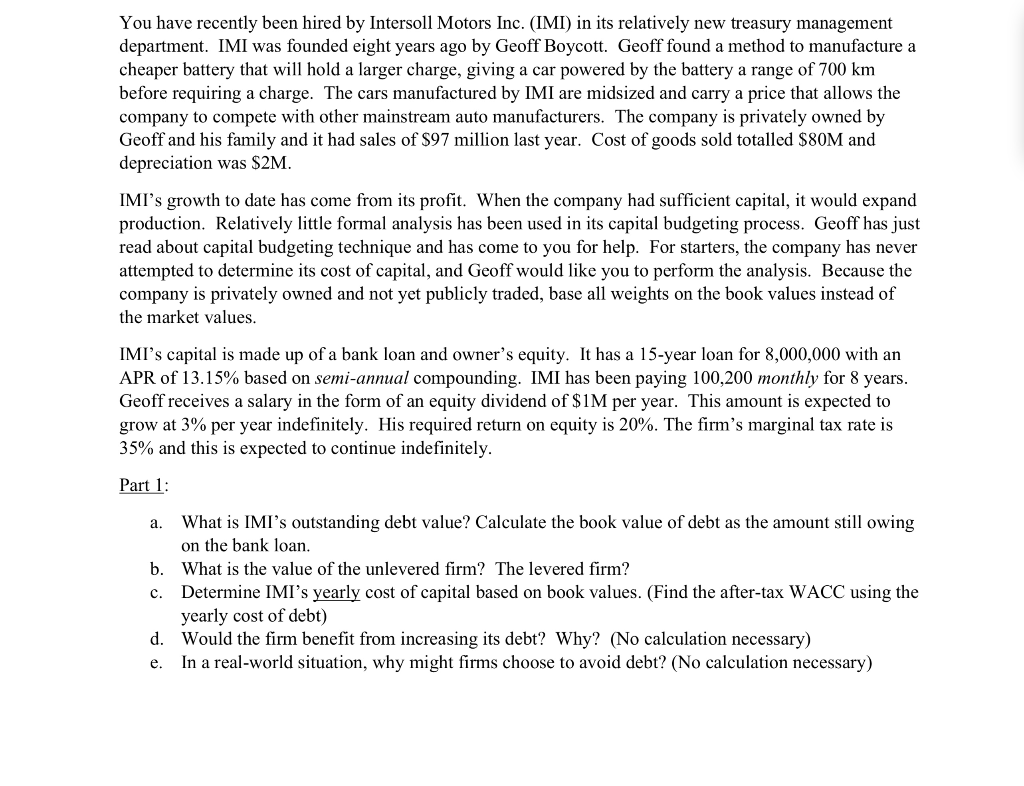
You have recently been hired by Intersoll Motors Inc. (IMI) in its relatively new treasury management department. IMI was founded eight years ago by Geoff Boycott. Geoff found a method to manufacture a cheaper battery that will hold a larger charge, giving a car powered by the battery a range of 700 km before requiring a charge. The cars manufactured by IMI are midsized and carry a price that allows the company to compete with other mainstream auto manufacturers. The company is privately owned by Geoff and his family and it had sales of $97 million last year. Cost of goods sold totalled $80M and depreciation was $2M. IMI's growth to date has come from its profit. When the company had sufficient capital, it would expand production. Relatively little formal analysis has been used in its capital budgeting process. Geoff has just read about capital budgeting technique and has come to you for help. For starters, the company has never attempted to determine its cost of capital, and Geoff would like you to perform the analysis. Because the company is privately owned and not yet publicly traded, base all weights on the book values instead of the market values. IMI's capital is made up of a bank loan and owner's equity. It has a 15-year loan for 8,000,000 with an APR of 13.15% based on semi-annual compounding. IMI has been paying 100,200 monthly for 8 years. Geoff receives a salary in the form of an equity dividend of $1M per year. This amount is expected to grow at 3% per year indefinitely. His required return on equity is 20%. The firm's marginal tax rate is 35% and this is expected to continue indefinitely. Part 1: a. What is IMI's outstanding debt value? Calculate the book value of debt as the amount still owing on the bank loan. b. What is the value of the unlevered firm? The levered firm? c. Determine IMI's yearly cost of capital based on book values. (Find the after-tax WACC using the yearly cost of debt) d. Would the firm benefit from increasing its debt? Why? (No calculation necessary) e. In a real-world situation, why might firms choose to avoid debt? (No calculation necessary) You have recently been hired by Intersoll Motors Inc. (IMI) in its relatively new treasury management department. IMI was founded eight years ago by Geoff Boycott. Geoff found a method to manufacture a cheaper battery that will hold a larger charge, giving a car powered by the battery a range of 700 km before requiring a charge. The cars manufactured by IMI are midsized and carry a price that allows the company to compete with other mainstream auto manufacturers. The company is privately owned by Geoff and his family and it had sales of $97 million last year. Cost of goods sold totalled $80M and depreciation was $2M. IMI's growth to date has come from its profit. When the company had sufficient capital, it would expand production. Relatively little formal analysis has been used in its capital budgeting process. Geoff has just read about capital budgeting technique and has come to you for help. For starters, the company has never attempted to determine its cost of capital, and Geoff would like you to perform the analysis. Because the company is privately owned and not yet publicly traded, base all weights on the book values instead of the market values. IMI's capital is made up of a bank loan and owner's equity. It has a 15-year loan for 8,000,000 with an APR of 13.15% based on semi-annual compounding. IMI has been paying 100,200 monthly for 8 years. Geoff receives a salary in the form of an equity dividend of $1M per year. This amount is expected to grow at 3% per year indefinitely. His required return on equity is 20%. The firm's marginal tax rate is 35% and this is expected to continue indefinitely. Part 1: a. What is IMI's outstanding debt value? Calculate the book value of debt as the amount still owing on the bank loan. b. What is the value of the unlevered firm? The levered firm? c. Determine IMI's yearly cost of capital based on book values. (Find the after-tax WACC using the yearly cost of debt) d. Would the firm benefit from increasing its debt? Why? (No calculation necessary) e. In a real-world situation, why might firms choose to avoid debt? (No calculation necessary)







